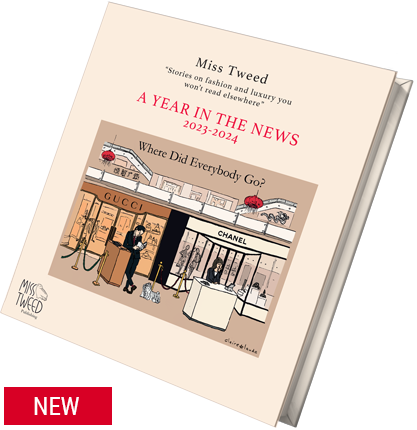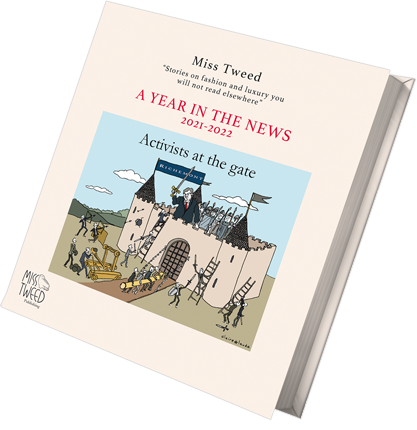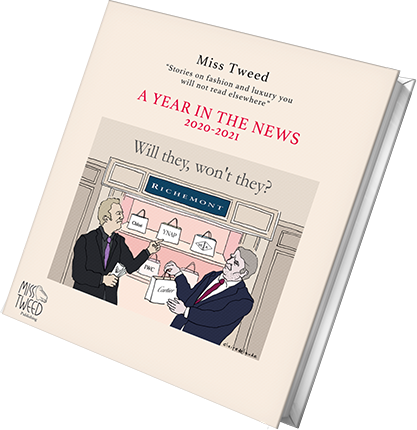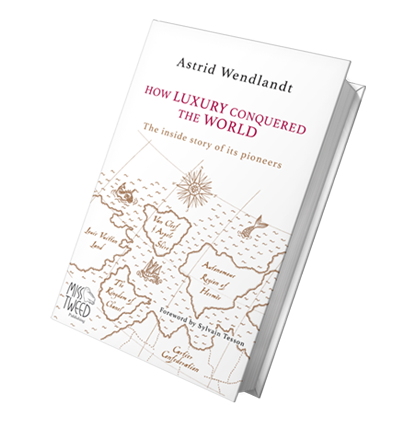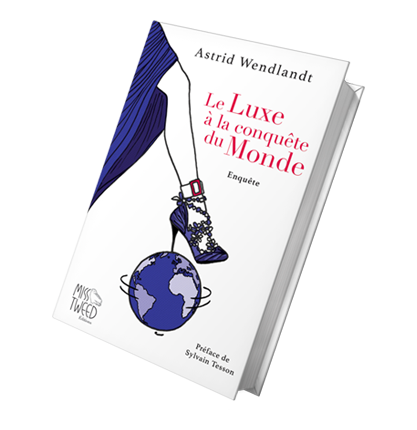If you are in Paris this summer, don't miss the exhibition at the Petit Palais "Worth. Inventing Haute Couture," which ends on September 7. It showcases the work of Charles Frederick Worth, British-French creator of haute couture, and father of the modern luxury fashion industry.
The retrospective brings together more than 400 works - clothing, objects and accessories, paintings and graphics - to create a vast fresco of the creations of the House of Worth, as well as the protagonists who have written its history. Almost 80 dresses illuminate the changing fashions under the House of Worth from the Second Empire to the Roaring Twenties, and reveal history as it is being created.
Worth’s background gave no indication of his storied ascent to the height of European glamour, royalty and influence. Born in England in 1825, in the provincial Lincolnshire market town of Bourne, he was the youngest of five children. Three of his older siblings died in childhood and his mother was left destitute after his father, a solicitor, abandoned the family.
Forced to seek his living early to survive, Worth went to London aged 11. By the time he was 12 he had found work as an apprentice for textile merchants. It was the time of the Industrial Revolution and Britain’s textile industry led the world. Smart, entrepreneurial, and, above all in pursuit of a fortune to put his hardscrabble youth behind him, Worth quickly rose up the ranks in London and then set sail for Paris, capital of the beau monde, in 1846 when he was 21.
He was hired as a senior clerk at Gagelin, a renowned textile and dress merchant, where he showed his entrepreneurial skill in selling silk fabrics, shawls, dresses, and coats, all industrially produced and adjusted for each customer. Worth’s coup de foudre came in 1851 when he met Marie Vernet, who would become his wife and his first model.
Paris back then was booming. Change was the order of the day under Emperor Napoleon III, who came to power in 1852. Under Napoleon’s great administrator, Baron Georges Haussmann, sweeping boulevards replaced the capital’s tight grid of medieval streets. In tune with the times, people wanted to change their clothing too. Worth, at the forefront of dressing this new era, became a partner in his employers' business just a year after Napoleon III’s coronation.
FATHER OF HAUTE COUTURE
A visionary, Worth left Gagelin and, in 1858, founded the house of “Worth et Bobergh” with his Swedish partner on the first floor of 7 rue de la Paix in Paris. There, he defined what a fashion house meant to him: a place that combined a studio, workshop, and boutique. At the time, the Place Vendôme neighborhood was home to many couturiers and jewelers, including Cartier.
In 1870, after separating from his Swedish partner, the company became simply “Worth” and came to embody French refinement and savoir-faire. The Princess of Metternich, wife of the Austrian ambassador to France, often wore his creations and gave Worth unexpected visibility, particularly with Empress Eugénie, who became one of his most famous customers, and an important patron of the arts in France.
The Second Empire (1852-1870) was a prosperous period. The opulence of the parties held at the Imperial Court attracted the European aristocracy and representatives of the fortunes being built in the new industrial era in Europe and in the French and British colonies.
In the 19th century, women's clothing consisted of crinoline dresses and voluminous petticoats, which restricted movement. A well-bred woman would change her outfit four to five times a day depending on her activities: a godsend for couturiers. Day dresses, afternoon dresses called tea gowns,opera coats, ball gowns, evening dresses, evening capes, and costumes for fancy dress balls.
Worth's innovations laid the foundations for haute couture. The couturier presented collections in his salons and customized designs for his clients. It was he who proposed and imposed his creations on the client, not the other way around.
Worth introduced a dress with interchangeable skirt and bodice. For daytime wear, it had long sleeves and a high neckline. For evening wear, the bodice and neckline were sleeveless. The crinoline dress replaced multiple heavy petticoats. Daytime dresses also featured a bustle, known as a pouf or faux-cul. The dresses were adorned with silk fringes and embroidery. Worth charged exorbitant prices and used only the finest fabrics. He was a boon to the silk houses of Lyon, such as Tassinari & Chatel, now owned by Lelièvre.
The Worth fashion house competed with others such as Paquin at 3 Rue de la Paix, Boué Sœurs at 9 Rue de la Paix, Doucet at 21 Rue de la Paix and, from 1899, Cartier, jeweler, at 13 Rue de la Paix.
The ties between the Worth and Cartier families were strengthened in 1898 with the marriage of Louis-François Cartier, founder of the Cartier company, and Andrée Caroline Worth, heiress to the Worth fashion empire. Then in 1907, Suzanne Cartier, granddaughter of Louis-François Cartier, married Jacques Worth, grandson of Charles Frederick. These unions gave rise to numerous collaborations between the two houses, notably on the occasion of the coronation of King Edward VII in 1902.
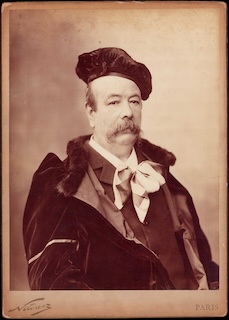
Worth also cultivated his image. His most famous portrait, photographed by Nadar in 1892, shows him with an imposing mustache, wearing a velvet beret, a smock adorned with a lavallière-style scarf and a loose-fitting velvet coat embroidered with fur at the collar.
THE SECOND GENERATION
Worth died in 1895, leaving his two sons, Jean-Philippe and Gaston, at the helm. They had already joined the family business a few years earlier and each had a defined role: Jean-Charles was in charge of design and Gaston was responsible for management.

In 1896, Jean-Philippe designed the Lily Dress for the Countess Greffulhe, an aristocrat and loyal customer of Worth, made from green satin silk with blue velvet motifs. This model is on display and will return to the archives for preservation, conservation, and transmission.
The Countess Greffulhe, to whom the Palais Galliera dedicated an exhibition in 2015, is said to have inspired Marcel Proust's character of the Duchess of Guermantes in his novel “In Search of Lost Time.”
The exhibition highlights dresses worn by Worth's prestigious clients, including the Sicilian aristocratFrancesca Jacona della Motta di San Giuliano, known as Franca Florio, the “Queen of Palermo”, and Lady Curzon, Vicereine of India. These clients, immortalized forever in their most beautiful Worth dresses, posed for painters Carolus-Duran, Antonio de La Gandara, Louise Catherine Breslau, and caricaturist and photographer Nadar.
Jean-Philippe and Gaston Worth were committed to continuing their father's work while adapting to the social and political changes of the 20thcentury. Success continued, as evidenced by the magazine Le Vrai et le Faux Chic:“They (the two Worth brothers) are continuing the tradition of their noble house, rejuvenating it with a modern fantasy.”
In 1901, Gaston recruited the young designer Paul Poiret to develop the Worth style. However, the collaboration lasted only two years. Against a backdrop of stylistic disagreements with Jean-Philippe Worth, Poiret left to found his own fashion house.
The Worth style evolved and gradually broke free from the sartorial codes of its founder and his era, offering a wardrobe in tune with the late 1910s. During the First World War, the Worth fashion house was converted into a hospital, taking in the wounded, and only resumed its activities at the end of the war.
THE THIRD GENERATION
Jacques and Jean-Charles Worth joined the family business in the early 1920s, taking over from their father Gaston, who died in 1924, and their uncle Jean-Philippe, who died in 1926.
The “Roaring Twenties” saw the emergence of a long, flowing silhouette, doing away with the corset that had restricted movement and caused women suffering and various health problems for centuries. Worth adapted to this new modernity. Vogue France wrote in April 1924: “One of the oldest fashion houses, it is nevertheless one of those that has best managed not only to adapt to modern tastes, but also to anticipate and inspire them.” This is the best definition of Worth.
While Chanel introduced its N°5 perfume in 1921 and Schiaparelli launched its "S" in 1929, Worth launched its first fragrance, Dans la nuit, in 1924 in a crystal bottle designed by René Lalique, featuring rounded shapes, midnight blue, and stars. The Worth fashion house launched several perfumes between 1925 and 1933: Vers le jour, Sans Adieu, Je Reviens, and Vers Toi.
The house began photographing its designs to register them, thereby ensuring their intellectual property protection. These registrations, now held by the Archives de Paris, are an invaluable testimony to Jean-Charles Worth's style for the family business. Liberating the body and waistline, he defined a new silhouette. Gabrielle Chanel would do the same with a sporty-chic style, flowing fabrics, knitwear, and suits.
During World War II, the Worth House was once again converted into a hospital.
THE POST-WAR PERIOD AND DECLINE
After the Second World War, rationing, including on fabrics, was still in force and haute couture clients became scarcer. Worth's designs were no longer suited to the needs of the time. In 1941, after the death of Jacques Worth, his sons Roger and Maurice took over the management of the house.
In December 1946, Christian Dior presented his first collection in January 1947, which was a huge success with his famous New Look. Roger Worth, the founder's great-grandson, retired in 1952. The house was sold in 1954 to Paquin, which became Paquin-Worth, but it closed its doors in 1956. This was, nonetheless, a natural creative progression. Dior’s New Look, and especially its Bar Jacket, which gave women after the austerity of the war years a sense of beauty in dressing, had in its inspiration Worth’s earlier innovation of a daytime dress with interchangeable skirt and bodice with long sleeves and a high neckline.
HAUTE COUTURE STATUS
Worth cannot be separated from the history of the Chambre Syndicale de la Couture Parisienne, as it was known before becoming the Fédération de la Haute Couture et de la Mode in 2017, in line with developments in the sector.
The Chambre Syndicale de la Haute Couture was founded in 1911 on the basis of an initial organization initiated by Charles Frederick Worth in 1868, which at the time was called the Chambre Syndicale de la Confection et de la Couture pour Dames (Trade Union of Women's Clothing and Dressmakers), intended to protect against copies. In 1913, Jacques Worth became an active member, alongside Paul Poiret, of the Union for the Defense of French Haute Couture and Related Industries, which defended the creations of fashion houses against unauthorized copies. The couturier Lucien Lelong worked to defend it during the Second World War, preventing the transfer of fashion houses and their expertise to Berlin, as the German authorities wanted during the Occupation.
Since 1945, the term “Haute Couture” has been legally protected. Only fashion houses approved by a dedicated commission are allowed to use it. The Haute Couture designation meets specific criteria, including handcrafting in in-house workshops, one specializing in flou and the other in tailoring. At least 25 designs must be presented per fashion show, and the house must have a dedicated salon to receive clients and create unique, made-to-measure pieces.
More alive than ever, Haute Couture is a field of endless expression and creativity, contributing to the influence of French expertise, craftsmanship, and luxury.
The Worth exhibition has been supported by Chanel, which has been presenting Haute Couture collections for over a century. The house's new artistic director, Matthieu Blazy, will unveil his first ready-to-wear collection in September and his Haute Couture collection in January 2026.
(Edited by RHS, photos by Astrid Wendlandt)
©Copyright Miss Tweed. The reproduction, sharing and diffusion (photocopies and screen shots) of this article are strictly forbidden without written permission by parent Miss Tweed Publishing. It is also forbidden to share Miss Tweed log-ins and passwords with third parties. Miss Tweed reserves the right to cancel a person’s subscription if this happens.










